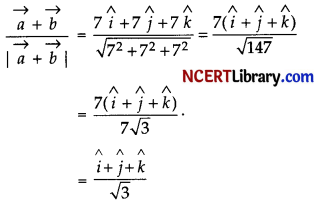Practicing the CBSE Sample Papers for Class 12 Maths with Solutions Set 6 allows you to get rid of exam fear and be confident to appear for the exam.
CBSE Sample Papers for Class 12 Maths Set 6 with Solutions
Time : 3 Hours
Maximum Marks: 80
General Instructions :
- This question paper contains five sections – A. B. C. D and E. Each section is compulsory. However, there are internal choices in some questions.
- Section – A has 18 MCQ’s and 02 Assertion-Reason based questions of 1 mark each.
- Section – B has 5 Very Short Answer (VSA)-type questions of 2 marks each.
- Section – C has 6 Short Answer (SA)-type questions of 3 marks each.
- Section – D has 4 Long Answer (LA)-type questions of 5 marks each.
- Section – E has 3 source based/case based/passage based/integrated units of assessment (4 marks each) with sub parts.
Section – A
(Multiple Choice Questions)
Each question carries 1 mark
Question 1.
If A is a matrix of order 3×4, then each row of A has:
(a) 3 elements
(b) 12 elements
(c) 7 elements
Solution:
(d) 4 elements
Explanation: Since 3 x 4 signifies that there are 3 rows and 4 columns. Then each row has 4 elements.
Question 2.
The area of the triangle formed by 3 collinear points is:
(a) one
(b) two
(c) zero
(d) four
Solution:
(c) zero
Explanation: The area of triangle formed by three collinear points is zero.
Question 3.
Which of the following function is decreasing on (0,\(\frac { π }{ 2 }\)) ?
(a) sin 2x
(b) tan x
(c) cos x
(c) cos 3x
Explanation:
In the interval (0,\(\frac { π }{ 2 }\)), f(x) = cosx
⇒ f'(x) = – sin x
which gives f'(x) < 0 in (0,\(\frac { π }{ 2 }\))
Hence , f(x) = cosx in decreasing in (0,\(\frac { π }{ 2 }\))
Question 4.

(a) f(x) is continuous at x = 0 for any value of 1
(b) f(x) is discontinuous at x – 0 for any value of 1
(c) f(x) is discontinuous at x – 1 for any value of 1
(d) None of the above
Solution:
(b) f(x) is discontinuous at x = 0 for any value of 1
![]()
Question 5.
Let f: R → R be defined as

Then f(-1) + f(2) + f(4) =
(a) 9
(b) 14
(c) 5
(d) None of these
Solution:
(a) 9
Explanation: f (-1) = 3(-1) = – 3
f (2) = (2)2 = 4
f(4) = 2 x 4 = 8
f(-1) + f(2) + f(3) = – 3 + 4 + 8 = 9.
![]()
Question 6.
The degree of the differential equation

(a) 1
(b) 2
(c) 3
(d) 4
Solution:
(b) 2
Explanation: We have

So, order = 2
and degree = 2
Question 7.
An optimisation problem may involve finding:
(a) maximum profit
(b) minimum cost
(c) minimum use of resources
(d) all of the above
Solution:
(d) all of the above
Explanation: An optimisation problem may involve finding maximum profit, minimum cost or minimum use of resources etc.
Question 8.
Find the interval in which the function, f(x) = sin x + cos x, 0 ≤ x ≤ 2 π is decreasing:
(a) (\(\frac { π }{ 4 }\), \(\frac { 5π }{ 4 }\))
(b) (\(\frac { -π }{ 4 }\), \(\frac { 5π }{ 4 }\))
(c) (\(\frac { π }{ 4 }\), \(\frac { -5π }{ 4 }\))
(d) (\(\frac { -π }{ 4 }\), \(\frac { π }{ 4 }\))
Solution:
(a) (\(\frac { π }{ 4 }\), \(\frac { 5π }{ 4 }\))
Explanation:
f(x) = sin x + cos x
f'(x) = cos x – sin x
Now, f'(x) = 0 gives
sin x = cos x,
which gives that x = \(\frac { π }{ 4 }\), \(\frac { 5π }{ 4 }\) as 0 ≤ x ≤ 2 π.
Question 9.

(a) sin x + C
(b) cos x + C
(c) tan x + C
(d) 0
Solution:
(c) tan x + C
Explanation:
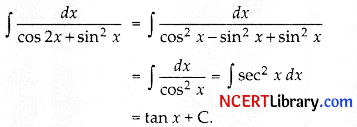
Question 10.

then a2 + b2 is equal to:
(a) 20
(b) 22
(c) 12
(d) 10
Solution:
(a) 20
Explanation: We have
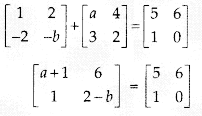
⇒ a + 1 = 5, 2 – b = 0
⇒ a = 4, b = 2
⇒ a2 + b2 = 42 + 22 = 20
![]()
Question 11.
The linear inequalities or equations or restrictions on the variables of a linear programming problem are called:
(a) linear relation
(b) constraints
(c) functions
(d) objective functions
Solution:
(b) constraints
Explanation: The restrictions on the variable of a linear programming problem are called constraints.
Question 12.
If M11 = – 40, M12 = – 10 and M13 = 35 of the determinant

then the value of ∆ is:
(a) -80
(b) 60
(c) 70
(d) 100
Solution:
(a) -80
Explanation:
∆ = a11A11 + a12A12 + a13A13
= a11M11 – a12M12 + a13M13
= 1 (- 40) – 3( – 10) + ( – 2) (35)
= – 40 + 30 – 70 = – 80
Question 13.

then the colador A21 is:
(a) – (hc + fg)
(b) fg – hc
(c) fg + hc
(d) hc – fg
Solution:
(b) fg – hc
Explanation:

Question 17.
If P (A∩B) = \(\frac { 7 }{ 10 }\) and P(B) = \(\frac { 7 }{ 20 }\), then P(A|B) is equal to :
(a) \(\frac { 14 }{ 17 }\)
(b) \(\frac { 17 }{ 20 }\)
(c) \(\frac { 7 }{ 8 }\)
(d) \(\frac { 1 }{ 8 }\)
Solution:
(a) \(\frac { 14 }{ 17 }\)
Explanation:
P (A∩B) = \(\frac { 7 }{ 10 }\) and P(B) = \(\frac { 7 }{ 20 }\)
P(A|B) = \(\frac { P (A∩B) }{ p(B) }\) = \(\frac { 7/10 }{ 17/20 }\) = \(\frac { 14 }{ 17 }\)
![]()
Question 15.
The degree of differential equation \(\frac{d^2 y}{d x^2}\) + \(\left(\frac{d y}{d x}\right)^3\) + 65y5 = 0 is :
(a) 1
(b) 2
(c) 3
(d) 5
Solution:
(a) 1
Explanation:
\(\frac{d^2 y}{d x^2}\) + \(\left(\frac{d y}{d x}\right)^3\) + 65y5 = 0
We know that, the degree of a differential equation is exponent highest of order derivative.
∴ Degree = 1.
Question 16.
If f(x) = 2x and g(x) = \(\frac{x^2}{2}\) + 1, then which of the following can be discontinuous functions?
(a) f(x) + g(x)
(b) f(x) – g(x)
(c) f(x) . g(x)
(d) \(\frac { g(x) }{ f(x) }\)
Solution:
(d) \(\frac { g(x) }{ f(x) }\)
Explanation: Weknow that, if f and g are continuous functions, then
(a) f + g is continuous
(b) f – g is continuous
(c) fg is continuous
(c) \(\frac { f }{ g }\) is continuous at these points, where g(x) ≠ 0.
Here,
\(\frac { g(x) }{ f(x) }\) = \(=\frac{\frac{x^2}{2}+1}{2 x}\) = \(\frac{x^2+2}{4 x}\)
which is discontinuous at x = 0.
Question 17.
Direction ratios of the line represented by the equation x = ay + b, z = cy + d are:
(a) (a, 1, c)
(b) (a, b – d, c)
(c) (a, 1,a)
(d) (b, ac, d)
Solution:
(a) (a, 1, c)
Explanation:
Given, x = ay + b, z = cy + d
∴y = \(\frac { x – b }{ a }\), y = \(\frac { z – d }{ c }\)
∴ \(\frac { x – b }{ a }\) = \(\frac { y }{ 1 }\) = \(\frac { z – d }{ c }\)
Hence direction ratios are (a, 1, c).
Question 18.
If \(\vec{a}\) . \(\vec{a}\) = 0, then \(\vec{a}\) is a:
(a) Unit vector
(b) Free vector
(c) Null vector
(d) None of these
Solution:
(c) Null vector
Explanation: By property of vectors, if \(\vec{a}\) . \(\vec{a}\) = 0, then \(\vec{a}\) is called null vector.
Assertion-Reason Based Question
In the following questions, a statement of assertion (A) is followed by a statement of Reason (R)
Choose the correct answer out of the following choices.
(a) Both A and R are true and R is the correct explanation of A.
(b) Both A and R arc true but R is not the correct explanation of A.
(c) A is true but R is false.
(d) A is false but R is true.
![]()
Question 19.
Assertion (A): A function y = f(x) is defined by x2 – cos-1 y = π, then domain of f(x) is R.
Reason (R) : cos-1 y ∈ [0, π]
Solution:
(d) A is false but R is true.
Explanation:
x2 – cos-1 y = π
cos-1 y = (x2 – π)
0 ≤ cos-1 y ≤ π
0 ≤ x2 – π ≤ π
π ≤ x2 ≤ 2π
∴ x ∈[-\(\sqrt{2π}\), – \(\sqrt{π}\)]∪[\(\sqrt{π}\), \(\sqrt{2π}\)]
Hence domain of f(x) is not real number.
Question 20.
Assertion (A): AIf \(\vec{a}\) and \(\vec{b}\) are reciprocal vectors, then \(\vec{a}\) . \(\vec{b}\) = 1.
Reason (R) : If \(\vec{a}\) and \(\vec{b}\) are reciprocal, then \(\vec{a}\) = λ \(\vec{b}\), λ ∈ R+ and |\(\vec{a}\)| |\(\vec{b}\)| = 1
Solution:
(a) Both A and R are true and R is the correct explanation of A.
Explanation: If \(\vec{a}\) and \(\vec{b}\) are reciprocal, then
\(\vec{a}\) = λ \(\vec{b}\), λ ∈ R+ and |\(\vec{a}\)| |\(\vec{b}\)| = 1
|\(\vec{a}\)| = λ |\(\vec{b}\)|
|λ| = \(\frac{|\vec{a}|}{|\vec{b}|}\) = \(\frac{1}{|\vec{b}|^2}\)
λ ∈ R+
λ = \(\frac{1}{|\vec{b}|^2}\)
\(\vec{a}\) = \(\frac{\vec{b}}{|\vec{b}|^2}\)
\(\vec{a}\) . \(\vec{b}\) = \(\frac{\vec{b}}{|\vec{b}|^2}\) . \(\vec{b}\) = \(\frac{|\vec{b}|^2}{|\vec{b}|^2}\) = 1
Section – B
This section comprises of very short answer type-questions (VSA) of 2 marks each
Question 21.
Using principal value, find the value of cos-1(\(\frac { 13π }{ 6 }\))
OR
What is the principal value of sec-1 (-2)?
Solution:
As principal value of cos-1 θ is [0, π]
cos-1(\(\frac { 13π }{ 6 }\)) = cos-1[cos(2π + \(\frac { π }{ 6 }\))]
= cos-1(\(\frac { π }{ 6 }\))
= \(\frac { π }{ 6 }\) ∈[0,π]
= cos-1 (cos \(\frac { 13π }{ 6 }\)) = \(\frac { π }{ 6 }\)
OR
We know that principal value of sec-1 θ is [0,π] – {-\(\frac { π }{ 2 }\)}
sec-1(-2) = sec-1 (-sec \(\frac { π }{ 3 }\))
= π – sec-1 (sec \(\frac { π }{ 3 }\)) (∵sec-1 (-x) ⇒ π – sec-1 x)
= π – \(\frac { π }{ 3 }\)
= \(\frac { 2π }{ 3 }\) ∈[0,π] – {-\(\frac { π }{ 2 }\)}
Question 22.
A balloon, which always remaîns spherical has a variable diameter \(\frac { 3 }{ 2 }\) (2x + 3). The rate of change of volume with respect to x is …………….
Solution:
\(\frac { 27 }{ 8 }\)π (2x + 3)2
let V be the volume of the balloon.
Radius of spherical balloon = \(\frac { 3 }{ 4 }\) (2x + 3)
Since V = \(\frac { 4π }{ 3 }\) (radius)3
Then
V = \(\frac { 4π }{ 3 }\) {\(\frac { 3 }{ 4 }\) (2x + 3}3
= \(\frac { 9π }{ 16 }\) (2x + 3)3
On differentiating V with respect to x, we get
\(\frac { dV }{ dx }\) = \(\frac { 9π }{ 16 }\) 3 (2x + 3)2 \(\frac { d }{ dx }\) (2x + 3)
Hence \(\frac { dV }{ dx }\) = \(\frac { 27π }{ 8 }\)(2x + 3)2
![]()
Question 23.
Equation of line is \(\frac { 4 – x }{ 2 }\) = \(\frac { y + 3 }{ 2 }\) = \(\frac { z + 2 }{ 1 }\) Find the direction cosines of a line parallel to above line.
OR
The equations of a line are 5x – 3 = 15y + 7 = 3 – 10 z. Write the direction cosines of the line.
Solution:
Given equation of line can be written as
\(\frac { 4 – x }{ 2 }\) = \(\frac { y + 3 }{ 2 }\) = \(\frac { z + 2 }{ 1 }\)
∵ Direction cosines of line parallel to above line are given by

Hence, required direction cosines of a line parallel to the given line is (-\(\frac { 2 }{ 3 }\), \(\frac { 2 }{ 3 }\), \(\frac { 1 }{ 3 }\))
OR
Givenlineis 5x – 3 = 15y + 7 = 3 – 10z
Rewritting the equation in standard form:
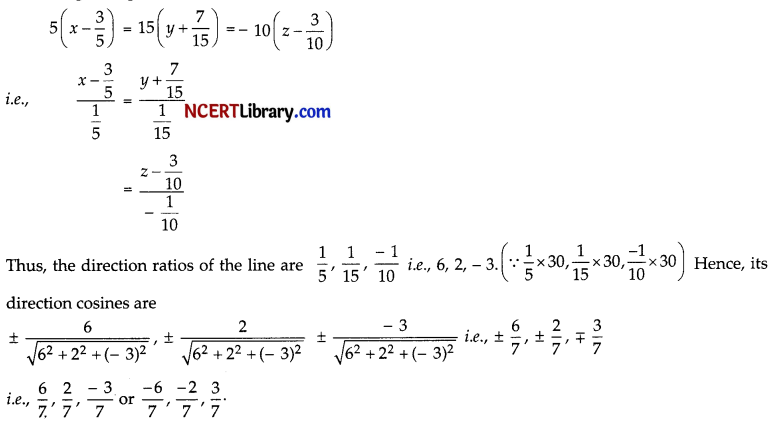
Question 24.
Write integrating factor of the following differential equations:
(i) \(\frac { dy }{ dx }\) + \(\frac{1}{1+x^2}\) y = sin x
(ii) x \(\frac { dy }{ dx }\) + y log x = x + y
Solution:
(i) Give differential equation is,
\(\frac { dy }{ dx }\) + \(\frac{1}{1+x^2}\) y = sin x
Integrating factor of above equation is given by

(ii) Given differential equation is,
x \(\frac { dy }{ dx }\) + y log x = x + y
\(\frac { dy }{ dx }\) + \(\frac { logx }{ x }\)y = \(\frac { x+y }{ x }\)
Integrating factor of above equation is given by
![]()
Question 25.
The length, x of a rectangle is decreasing at the rate 5 cm/minute and the width, y is increasing at the rate of 4 cm/minute. When x – 8 cm and y = 6 cm, find the rate of change of the area of the rectangle.
Solution:
We have,
\(\frac { dy }{ dt }\) = -5 cm/min ……………….(i)
and \(\frac { dy }{ dt }\) = 4 cm/min …………..(ii)
Now, area of the rectangle (A) = xy
\(\frac { dA }{ dt }\) = x \(\frac { dy }{ dt }\) + y \(\frac { dx }{ dt }\)
\(\frac { dA }{ dt }\) = x (4) + y (-5) [using (i) and (ii)]
\(\frac { dA }{ dt }\) = 4x – 5y
when x = 8 cm and y = 6cm,

= 32 – 30
= 2 cm2/min
Hence, the rate of change of the area of the rectangle is 2 cm2/min.
Section – C
This section comprises of short answer type questions (SA) of 3 marks each
Question 26.

Solution:
Let
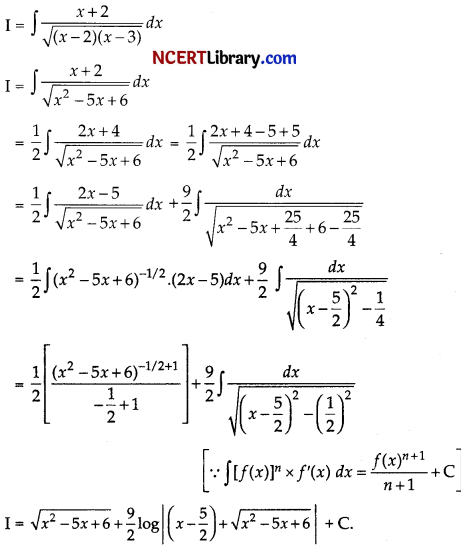
Question 27.
A box has 2 apples out of which one is red and other is green. What is the probability that both of them are bad, if it is known that (i) the red apple is bad, (ii) and green apple is bad.
OR
An electronic assembly consists of two sub-systems, say A and B. From previous testing procedures, the following probabilities are assumed to be known:
P(A fails) = 0.2
P(B fails alone) = 0.15
P(A and B fail) = 0.15
Evaluate the following probabilities:
(i) P(A) fails given that B has failed, (ii) P(A) fails alone.
Solution:
Let Bi and Gi denote the apples to be bad and good respectively where i ∈ {R, G}. R stands for red apple and G for green apple.
Then sample space is S = {GRGG BRGG, BRBG, GRBG)
Let us consider the events
A = both apples are bad
B = red apple is bad
C = green apple is bad
Then, A = {BR, BG}, B = {BRGG, BRBG} and C = {BRGG, BRBG}
and A ∩ B = {BR, BG}, A ∩ C = {BR, BG}
(i) Required Probability = P (A/B)
\(\frac{\mathrm{P}(\mathrm{A} \cap \mathrm{B})}{\mathrm{P}(\mathrm{B})}\) = \(\frac { 1/4 }{ 2/4 }\) = \(\frac { 1 }{ 2 }\)
(ii) Required Probability = P (A/C)
\(\frac{\mathrm{P}(\mathrm{A} \cap \mathrm{C})}{\mathrm{P}(\mathrm{C})}\) = \(\frac { 1/4 }{ 2/4 }\) = \(\frac { 1 }{ 2 }\)
OR
Let the event in which A fails and B fails be denoted by EA and EB respectively.
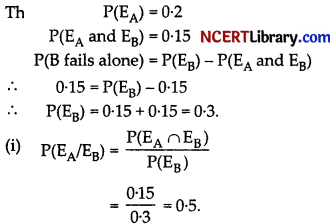
(ii)
P(A fails alone) P(EA) – P(EA and EB)
0.2 – 0.15
= 0.05.
![]()
Question 28.
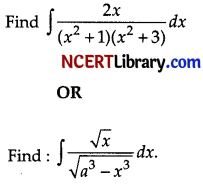
Solution:
We have,
![]()
Put x2 = t
Differentiate both side w.r.t.x
2x dx = dt

Multiply both sides by (t + 1) (t + 3)
1 = A(t + 3) + B(t + 1) ……………. (i)
Put
t = – 1 in equation (i)
then 1 = A(- 1 + 3)
1 = 2A
A = \(\frac { 1 }{ 2 }\)
t = – 3
Put the value in equation (j)
then 1 = B ( – 3 + 1)
1 = – 2B
B = – \(\frac { 1 }{ 2 }\)
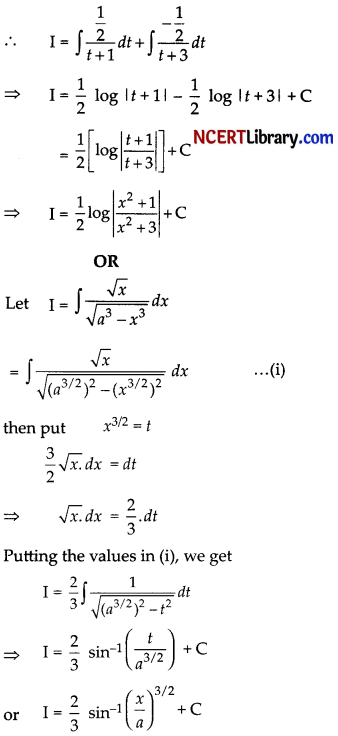
Question 29.
Find the particular solution of the differential equation (1 – y2) (1 + log x) dx + 2xy dy = 0, given that y = 0
when x = 1.
OR
Find the particular solution of the following differential equation:
\(\frac { dy }{ dx }\) = 1 + x2 + y2 + x2y2
Given that y = 1, when x = 0.
Solution:
The given differential equation is
(1 – y2) (1 + logx) dx + 2xy dy = 0

Question 30.
Find ∫ tan3 2x sec 2x dx =
Solution:
I = ∫ tan2 2x tan 2x sec 2x dx
= ∫ (sec2 2x – 1) tan 2x sec 2x dx
Put sec 2x = t
Differentiate both sides w.r.t.x
2 sec 2x tan 2x = \(\frac { dt }{ dx }\)
∴ sec 2x tan 2x dx = \(\frac { dt }{ 2 }\)
I = \(\frac { 1 }{ 2 }\) ∫ (t2 – 1) dt
⇒ I = \(\frac { 1 }{ 2 }\) [\(\frac{t^3}{3}\) – t] + C
⇒ I = \(\frac { 1 }{ 2 }\) [ \(\frac{\sec ^3 2 x}{3}\) – sec 2x] + C
⇒ I = \(\frac{\sec ^3 2 x}{6}\) – \(\frac { sec2x }{ 2 }\) + C
![]()
Question 31.
Maximize Z = x + 2y
subject to the constraints
x + 2y ≥ 100, 2x – y ≤ 0
2x + y ≤ 200, x , y ≥ 0
Solve the above LPP graphically.
Solution:
Given, maximize Z = x +
Subject to the constraints
x + 2y ≥ 100, 2x – y ≤ 0
2x + y ≤ 200, x , y ≥ 0
Converting the inequations into equations we obtain the lines x + 2y = 100, 2x – y = 0, 2x + y = 200.
Then, x + 2y = 100
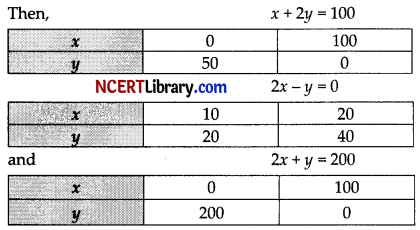
Plotting these points on the graph, we get the shaded feasible region, i.e., ADECA.

Clearly, the maximum value of Z is 400 at (0, 200).
Section – D
This section comprises of long answer type questions (LA) of 5 msrks each
Question 32.

Solution:
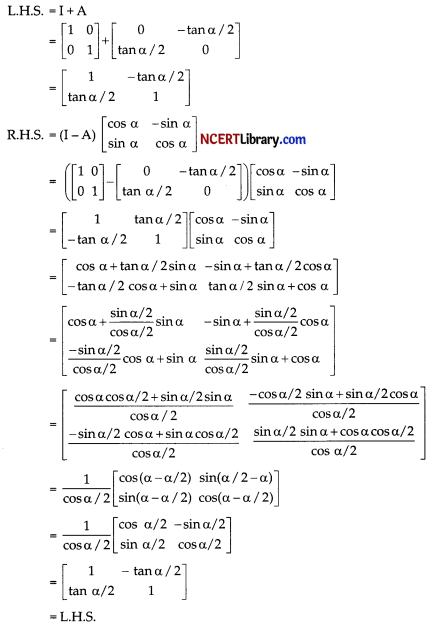
Question 33.
Find the length and foot of perpendicular drawn from the point (2, – 1, 5) to line
\(\frac { x – 1 }{ 10 }\) = \(\frac { y+2 }{ -4 }\) = \(\frac { z+8 }{ -11 }\)
OR
By computing the shortest distance, determine whether the following lines intersects or not
\(\frac { x – 1 }{ 2 }\) = \(\frac { y + 1 }{ 3 }\) = z and \(\frac { x + 1 }{ 5 }\) = \(\frac { y – 2 }{ 1 }\) = \(\frac { z – 2 }{ 0 }\)
Solution:
Let AB be the line whose equation is
\(\frac { x – 11 }{ 10 }\) = \(\frac { y + 2 }{ -4 }\) = \(\frac { z + 8 }{ -11 }\)
Let Q be the foot of perpendicular and PQ be the length of perpendicular.
Any point Q on the given line is given by
\(\frac { x – 11 }{ 10 }\) = \(\frac { y + 2 }{ -4 }\) = \(\frac { z + 8 }{ -11 }\) = λ(say)
x = 10λ + 11,
y = – 4λ – 2,
z = – 11λ – 8
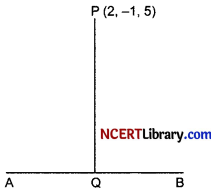
∴ Coordinates of Q are (10λ + 11, – 4λ – 2, -11λ – 8)
Now, direction ratios of the line PQ are (10λ + 11 – 2, – 4λ – 2 + 1, – 11λ – 8 – 5)
∴ Direction ratios of PQ (10λ + 9, – 4λ – 1, – 11λ – 13)
∵PQ ⊥AB
∴a1a2 + b1b2 + c1c2 = 0
Where a1 = 10λ + 9, b1 = – 4λ – 1, c1 = -11λ – 13
(Direction ratios of PQ)
and a2 = 10λ , b2 = -4, c2 = -11
(Direction ratios of AB)
∴ We get
10(10λ + 9) – 4(-4λ – 1) – 11(-11λ – 13) = 0
100λ + 90 + 16λ + 4 + 12λ + 143 = 0
237λ + 237 = 0
λ = -1
Puffing = – 1 in coordinates of point Q we get
Foot of perpendicular = Q( – 10 + 11, 4 – 2, 11 – 8)
= Q (1, 2, 3)
Also, length of perpendicular PQ is given by

OR
The given equations of the two lines are
\(\frac { x – 1 }{ 2 }\) = \(\frac { y + 1 }{ 3 }\) = \(\frac { z – 0 }{ 1 }\) ……………(i)
and \(\frac { x + 1 }{ 5 }\) = \(\frac { y – 2 }{ 1 }\) = \(\frac { z – 2 }{ 0 }\)
The vector equations of the above two lines are
\(\vec{r}\) = (\(\hat{i}\) – \(\hat{j}\) + 0\(\hat{k}\)) + λ(2\(\hat{i}\) + 3\(\hat{j}\) + \(\hat{k}\))
\(\vec{r}\) = (-\(\hat{i}\) + 2\(\hat{j}\) + 2\(\hat{k}\)) + μ(5\(\hat{i}\) + \(\hat{j}\))
Comparing these equations with \(\vec{r}\) = \(\overrightarrow{a_1}\) + \(\overrightarrow{b_1}\) and \(\vec{r}\) = \(\overrightarrow{a_2}\) + μ\(\overrightarrow{b_2}\), we have
\(\overrightarrow{a_1}\) = \(\hat{i}\) – \(\hat{j}\)
\(\overrightarrow{a_2}\) = \(\hat{i}\) + 2\(\hat{j}\) + 2\(\hat{k}\)
\(\overrightarrow{b_1}\) = 2\(\hat{i}\) + 3\(\hat{j}\) + \(\hat{k}\)
\(\overrightarrow{b_2}\) = 5\(\hat{i}\) + \(\hat{j}\)
Now, (\(\overrightarrow{a_2}\) – \(\overrightarrow{a_1}\)) = – 2\(\hat{i}\) + 3\(\hat{j}\) + \(\hat{k}\)
and
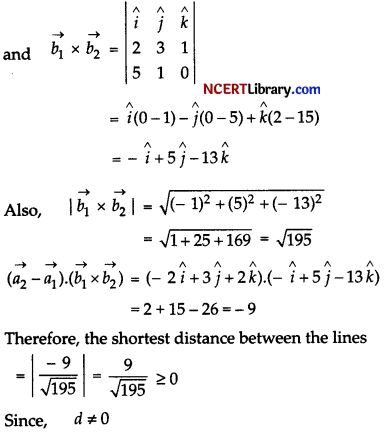
Hence, the given lines do not intersect.
![]()
Question 34.
Find the derivative of tan-1

with respect to x.
OR
Find the values of a and b such that the following function f(x) is a continuous function.
Solution:
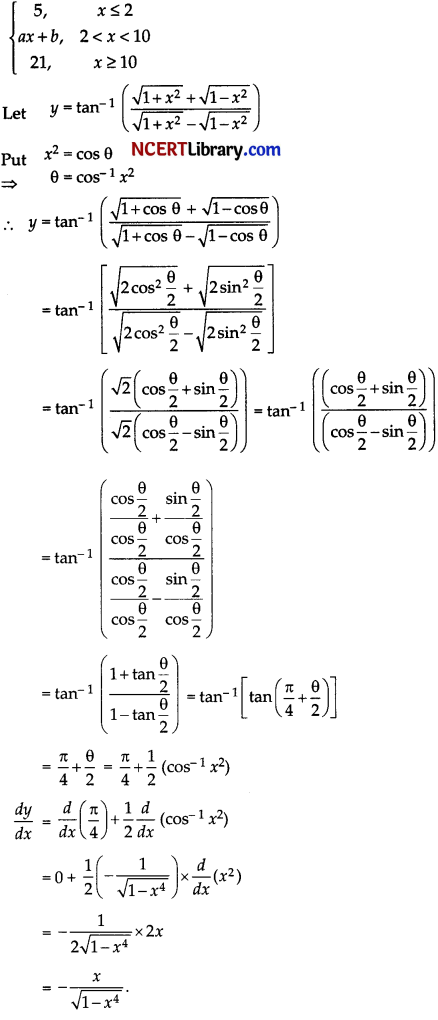
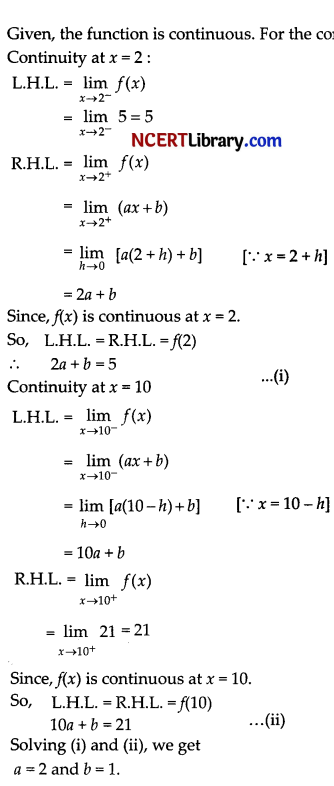
Question 35.
Find the area enclosed by the curve y = – x2 and the straight line x + y +2 = 0.
Solution:
Wehave, y = x2 and x + y + 2 = 0
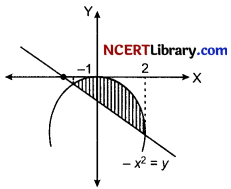
– x – 2 = – x2
x2 – x – 2 = 0
x2 + x – 2x – 2 = 0
x( x + 1 ) – 2 (x + 1) = 0
(x – 2) (x + 1) = 0
x = 2, – 1
∴Area of shaded region,
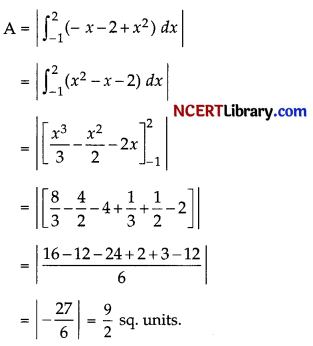
Section – E
This section comprises of 3 case-study/passage-based questions of 4 marks each with two sub-parts. First two case study questions have three sub-parts (i), (ii), (iii) of marks 1, 1, 2 respectively. The third case study question has two sub-parts of 2 marks each.)
Question 36.
Sanjay, Ajay and Vijay are three best friends. After compLeting their MBA from IIM Lucknow. They apply for the job in the same company for the post of manager in finance department. Chances of selection of Sarijay, Aay and Vijay are in the ratio of 1 : 2 : 4. The probabilities that Sanjay can increase the profits of the company by his efforts is 0.8 whereas probabilities for the same task of Ajay and Vijay are 0.5 and 0.3 respectively.
From the above information attempt the following questions:
(i) If E1, E2 and E3 are the events of selecting Sanjay, Ajay and Vijay, then find P(E1), P(E2) and P(E3).
(ii) A be event of increase the profit then find if it is due to Ajay.
(iii) Find P(E1/A).
OR
(iii) If E1, E2 and E3 be events of not increase the profits, then find the probability that it is due to the appointment of Vijay?
Solution:
(i) E1 be event of selecting Sanjay
E2 be event of selecting Ajay
E3 be event of selecting Vijay.
P(E1) = \(\frac { 1 }{ 7 }\)
P(E2) = \(\frac { 2 }{ 7 }\)
P(E3) = \(\frac { 4 }{ 7 }\)
(ii) A be the event of increasing profits.
P(A/E1) = 0.8
P(A/E2) = 0.5
P(A/E3) = 0.3
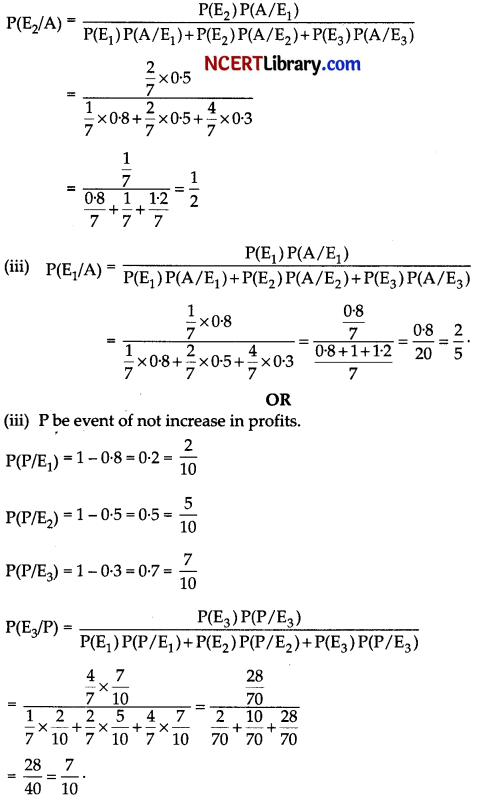
![]()
Question 37.
A retailer purchases two types of tea priced at ₹ 120 and ₹ 160 per kg. He wants to sell the mixtures of these two types of tea at a price of ₹ 150 per kg. If he bought total of 200 kg of tea.

Give the answer of the followng questions:
(i) If f (x) is function for the total purchase price of green tea + black tea, where x denotes the quantity (in kg) for Green tea, formulate the function f(x).
(ii) How much is the quantity of green tea to be purchased to earn the same revenue?
(iii) Find the value of f (400) – f (200)
OR
(iii) If g(x) = 2x +5 then find g(10):
Solution:
(i) Green tea = x
Black tea = 200 – x
f(x) – 120 x + (200 – x) 160
= 120x + 32000 – 160x
f(x) = ₹ 32000 – 40x
(ii) Total revenue 150 x 200 = 30,000
∴ 32,000 – 40x = 30,000
2000 = 40x
x = 50
(iii) f(400) = 32000 – 40 x 400
= 32000 – 16000
= ₹ 16000
f(200) = 32000 – 8000
= ₹ 24000
f(400) – f (200) = 16000 – 24000 = – 8000
OR
(iii) g(x) = 2x + 5
Now, g(10)= 2 x 10 + 5 = 25
Question 38.
Raja was flying a kite from a point A in the direction of \(\vec{a}\) = 5 \(\hat{i}\) + \(\hat{j}\) + 4 \(\hat{k}\) . His friend Soban was watching him from the point B which is horizontal to A with the position vector \(\vec{b}\) =2 \(\hat{i}\) + 6\(\hat{j}\) + 3\(\hat{k}\). The point B is just below the kite.
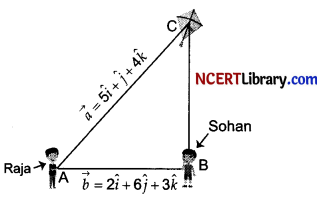
Answer the following questions:
(i) Find the projection of \(\vec{a}\) on \(\vec{b}\)?
(ii) Find a unit vector in the direction of \(\vec{a}\) and \(\vec{b}\) ?
Solution:
(i) Projection of \(\vec{a}\) and \(\vec{b}\) = \(\frac{\vec{a} \cdot \vec{b}}{|\vec{b}|}\)
\(\vec{a}\) . \(\vec{b}\) = (5\(\hat{i}\) + \(\hat{j}\) + 4\(\hat{k}\)).(2\(\hat{i}\) + 6\(\hat{j}\) + 3\(\hat{k}\))
= 10 + 6 + 12
= 28
Projection = \(\frac { 28 }{ 7 }\) = 4
(ii) Unit vector in the direction of \(\vec{a}\) + \(\vec{b}\) is
